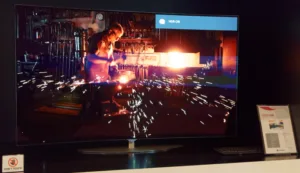On the the first morning of the show, we were able to get a detailed look at the developments at LG Display in its hotel suite. The company had a lot to show and we were there for a while, but it was worth it! (note that there are multiple pages in this article)
‘We started by looking at the large displays area, where, of course, OLED was the first topic. LG Display is looking to boost its OLED sales and the company has a real advantage in the manufacture of large OLEDs over other makers. As we reported from Latin Display, many think that the LG Display approach of using white OLED and colour filters is really exploiting a “work around” for the difficulties in making OLED displays in other ways, but in the end, LG is making panels that are providing very good performance and are shipping to customers, so it’s hard to criticise the approach.
LG Display’s HDR OLED had great performance in limited ambient lightingThe first 55″ OLED that we looked at was just 9Kg weight – a 65″ panel was just 13 Kg. The main point that LG was making was that OLED can support HDR applications, although the peak brightness is relatively low. On the other hand, the company was emphasising that OLED has a big advantage in maintaining accurate colour and brightness modulation at very low grey levels, where LCD struggles. The panels on display were fundamentally the same as LG’s current shipping product but were being driven differently to allow a peak brightness of 800 cd/m2. Providing ambient light is under control, the OLED technology is good at showing HDR content because of the deep black.
The next OLED that we looked at was a 65″ curved (5000mm radius) OLED with UltraHD 3840 x 2160 resolution. LG was highlighting the difficulties that LCD has in light leakage and brightness uniformity (especially in the corners) when LCD is curved. OLED does not suffer from these problems and so it can maintain its high end performance.

